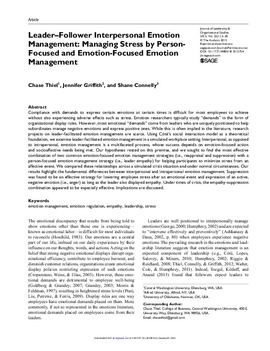| dc.contributor.author | Chase Thiel | |
| dc.contributor.author | Jennifer Griffith | |
| dc.contributor.author | Shane Connelly | |
| dc.date.accessioned | 2016-01-14T19:53:51Z | |
| dc.date.accessioned | 2016-03-30T15:35:03Z | |
| dc.date.available | 2016-01-14T19:53:51Z | |
| dc.date.available | 2016-03-30T15:35:03Z | |
| dc.date.issued | 2015-02-01 | |
| dc.identifier.citation | Thiel, C., Griffith, J., & Connelly, S. (2015). Leader–Follower Interpersonal Emotion Management: Managing Stress by Person-Focused and Emotion-Focused Emotion Management. Journal of Leadership & Organizational Studies, 22(1), 5-20. doi: 10.1177/1548051813515754 | en_US |
| dc.identifier.uri | https://hdl.handle.net/11244/25485 | |
| dc.description.abstract | Compliance with demands to express certain emotions at certain times is difficult for most employees to achieve without also experiencing adverse effects such as stress. Emotion researchers typically study “demands” in the form of organizational display rules. However, most emotional “demands” come from leaders who are uniquely positioned to help subordinates manage negative emotions and express positive ones. While this is often implied in the literature, research projects on leader-facilitated emotion management are scarce. Using Cóté’s social interaction model as a theoretical foundation, we examine leader-facilitated emotion management in a simulated workplace setting. Interpersonal, as opposed to intrapersonal, emotion management is a multifaceted process, whose success depends on emotion-focused action and socioaffective needs being met. Our hypotheses rested on this premise, and we sought to find the most effective combination of two common emotion-focused emotion management strategies (i.e., reappraisal and suppression) with a person-focused emotion management strategy (i.e., leader empathy) for helping participants to minimize stress from an affective event. We compared these relationships across a simulated crisis situation and under normal circumstances. Our results highlight the fundamental differences between interpersonal and intrapersonal emotion management. Suppression was found to be an effective strategy for lowering employee stress after an emotional event and expression of an active, negative emotion (i.e., anger) as long as the leader also displayed empathy. Under times of crisis, the empathy-suppression combination appeared to be especially effective. Implications are discussed. | en_US |
| dc.language.iso | en_US | en_US |
| dc.publisher | Journal of Leadership & Organizational Studies | |
| dc.subject | emotion management | en_US |
| dc.subject | emotion regulation | en_US |
| dc.subject | empathy | en_US |
| dc.subject | leadership | en_US |
| dc.subject | stress | en_US |
| dc.title | Leader–Follower Interpersonal Emotion Management: Managing Stress by Person-Focused and Emotion-Focused Emotion Management | en_US |
| dc.type | Research Article | en_US |
| dc.description.peerreview | Yes | en_US |
| dc.description.peerreviewnotes | https://us.sagepub.com/en-us/nam/manuscript-submission-guidelines | en_US |
| dc.identifier.doi | 10.1177/1548051813515754 | en_US |
| dc.rights.requestable | false | en_US |
